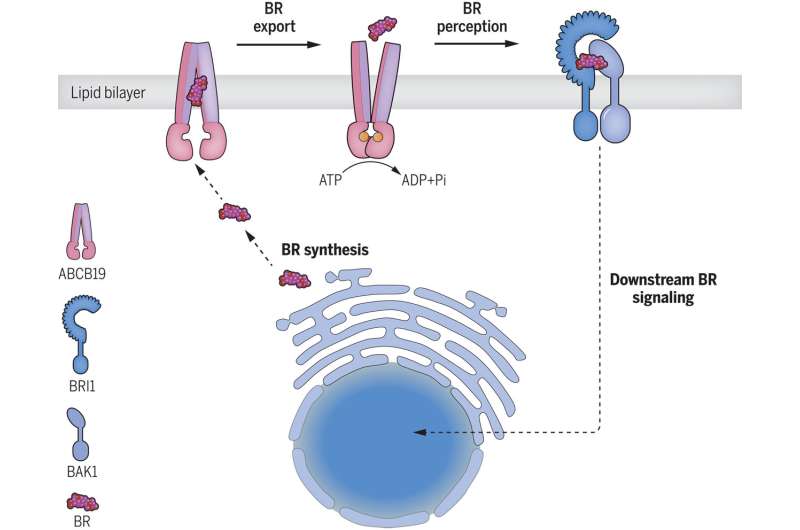In the intricate world of plant biology, hormones play a crucial role in regulating growth, development, and response to environmental stimuli. Among these hormones, brassinosteroids stand out as key players, governing various physiological processes essential for plant survival and adaptation. Despite their significance, the mechanism by which BRs are transported within plant cells has long remained a mystery. However, a groundbreaking study led by researchers from the University of Science and Technology of China has unveiled the enigmatic exporter responsible for shuttling BRs across cellular membranes—a discovery poised to revolutionize our understanding of plant hormone signaling.
The Significance of Brassinosteroids in Plant Biology
Brassinosteroids, often referred to as the “sixth phytohormone,” exert profound effects on plant growth and development. From seed germination to flowering and fruiting, BRs orchestrate a myriad of processes that dictate plant morphology and physiology. Moreover, BRs play a vital role in plant responses to various environmental stresses, making them invaluable targets for agricultural applications aimed at enhancing crop yield and resilience. Despite their importance, the precise mechanisms underlying BR transport have eluded scientists for decades, hindering efforts to fully exploit their potential in agriculture and biotechnology.
A Paradigm-Shifting Discovery
In a groundbreaking study published in the prestigious journal Science, a team of researchers led by Prof. Sun Linfeng from USTC and Prof. Eugenia Russinova from the VIB-UGent Center for Plant Systems Biology has made a landmark discovery—the identification of the first BR exporter in plants. This groundbreaking finding represents a significant leap forward in our understanding of plant hormone signaling and opens new avenues for manipulating BR levels to enhance crop productivity and stress tolerance.
The Role of ABCB19: From Auxin Transporter to Brassinosteroid Exporter
The focus of the researchers’ investigation was on a protein known as ABCB19, previously recognized as a transporter for the phytohormone auxin. However, intriguingly, the mutant phenotype of ABCB19 did not align entirely with that of typical auxin transporters, prompting the researchers to explore alternative substrates for this protein. Through a series of meticulous experiments, including ATPase activity assays and in vitro transport assays, the researchers demonstrated that ABCB19 exhibits a strong affinity for bioactive brassinosteroids, but not for auxins or BR biosynthesis precursors. This unexpected finding challenged conventional wisdom and led to the realization that ABCB19 serves as a bona fide exporter of brassinosteroids—a role that had gone unnoticed until now.
Unraveling the Molecular Mechanisms
To gain insights into the molecular mechanisms underlying BR transport by ABCB19, the researchers employed cutting-edge techniques such as cryo-electron microscopy. This state-of-the-art imaging technology allowed them to visualize the process of ABCB19 exporting brassinosteroids and elucidate the unique architecture of the protein that enables it to bind with BRs. Moreover, physiological and genetic analyses confirmed the pivotal role of ABCB19 in brassinosteroid signaling, cementing its status as the long-sought-after BR exporter in plants.
Implications for Agriculture and Biotechnology
The discovery of ABCB19 as the first BR exporter in plants holds immense implications for agriculture and biotechnology. By gaining a deeper understanding of BR transport mechanisms, scientists can devise novel strategies to modulate endogenous BR levels and distribution, thereby enhancing plant productivity and resilience. From engineering crop varieties with improved stress tolerance to optimizing hormone-based treatments for crop management, the possibilities are limitless.
Future Directions and Conclusion
As researchers continue to unravel the intricacies of plant hormone signaling, the identification of ABCB19 as the BR exporter represents just the beginning of a new era in plant biology. Future studies will undoubtedly focus on elucidating the regulatory mechanisms governing ABCB19 activation and substrate preference, as well as identifying additional BR exporters. Armed with this knowledge, scientists can harness the power of plant hormones to address global challenges such as food security and environmental sustainability. In closing, the discovery of ABCB19 as the first BR exporter heralds a new chapter in our quest to unlock the secrets of nature’s intricate machinery and harness its potential for the benefit of humanity.
